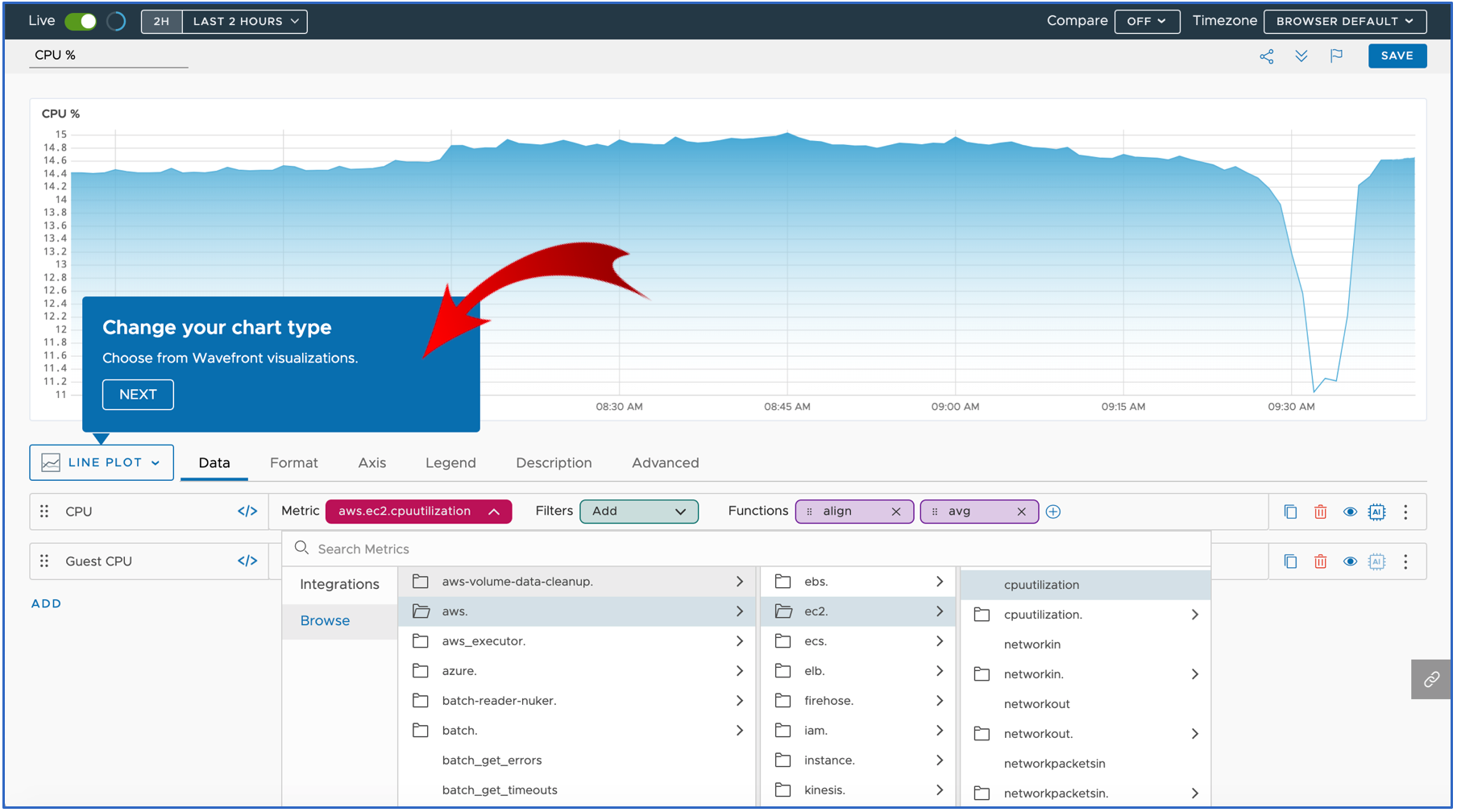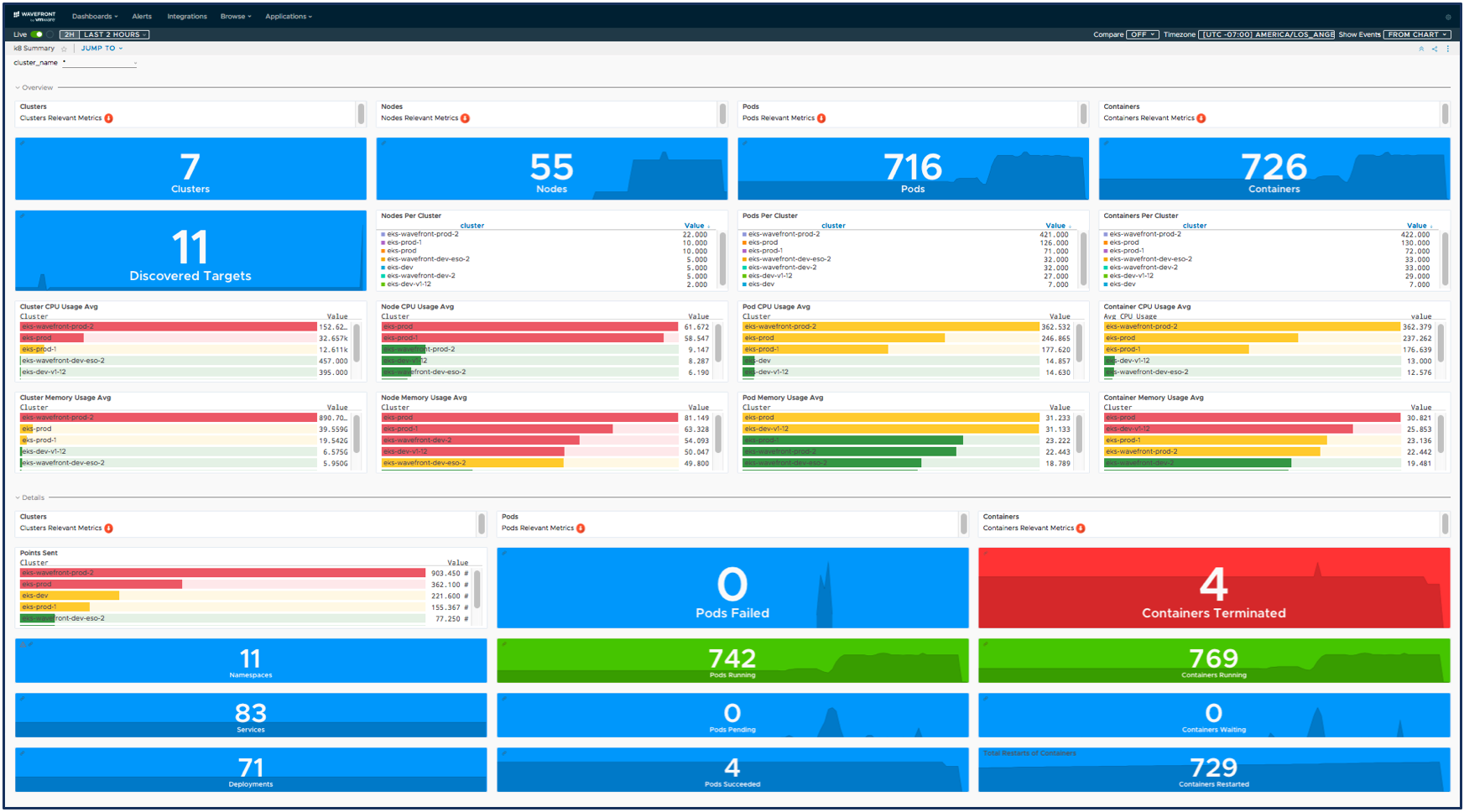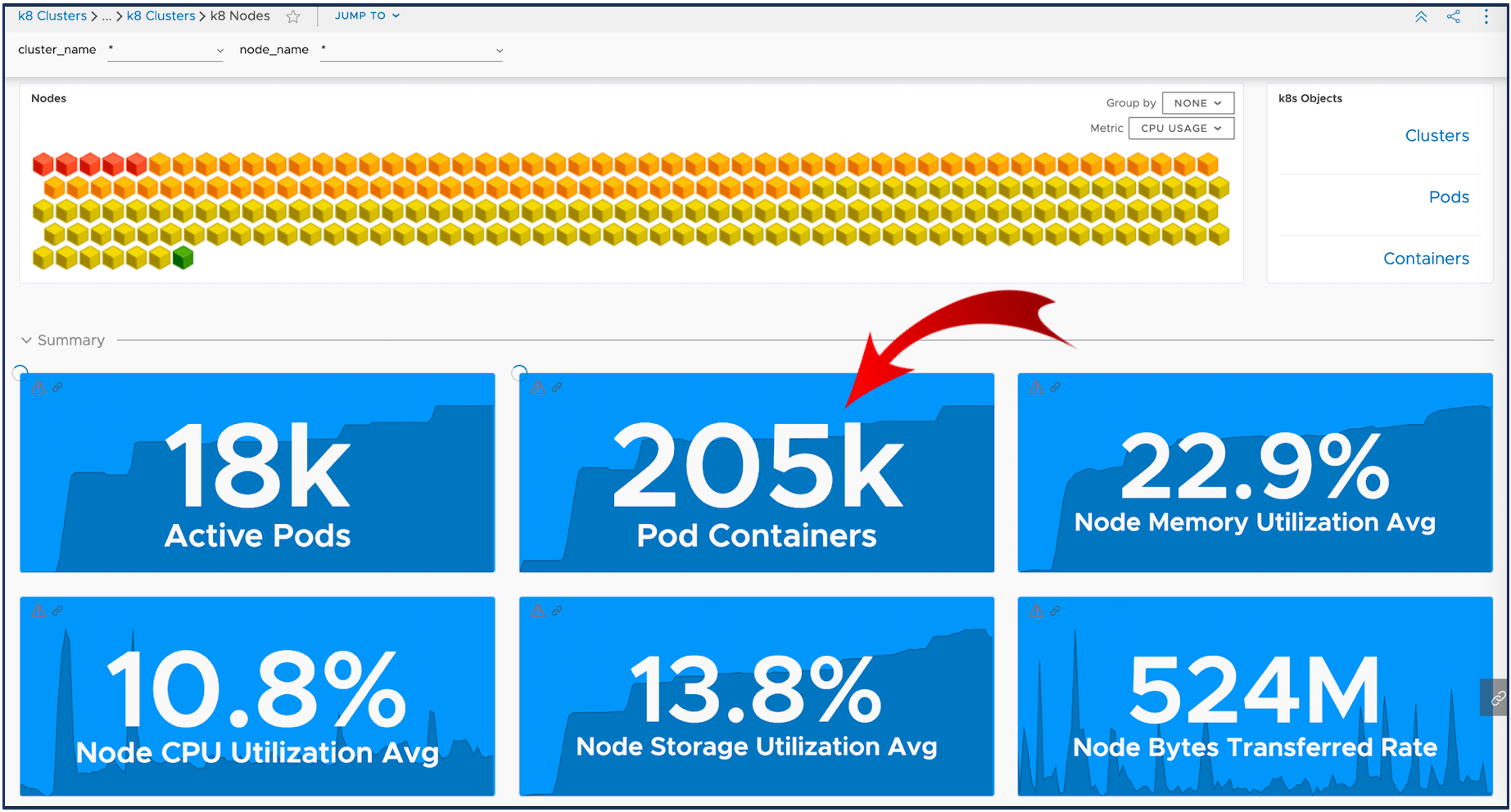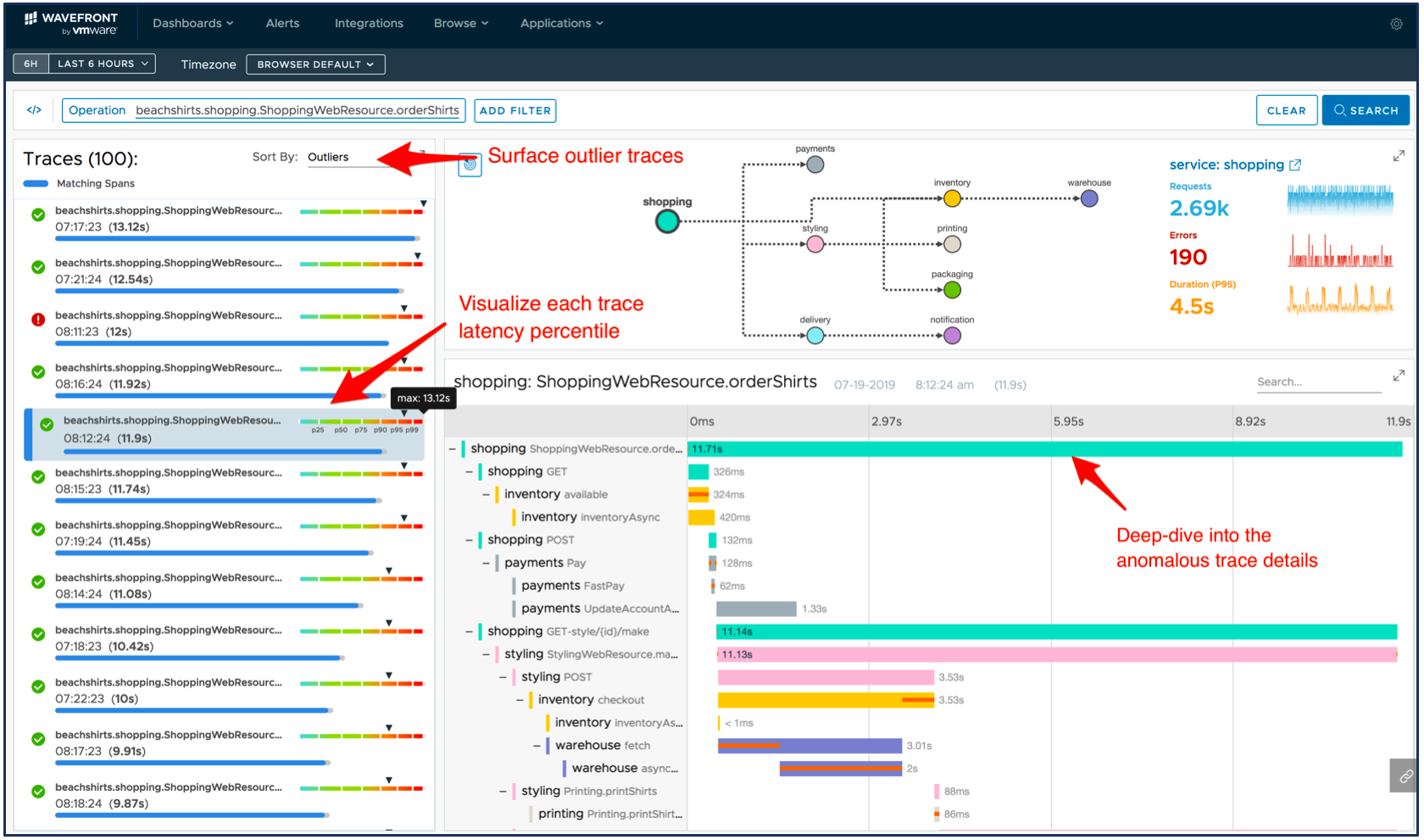With announcement at VMworld 2019 in San Francisco this week, the Wavefront platform is bolstered with many enterprise observability capabilities. Our primary aim is to empower Kubernetes platform operators, SREs, DevOps and developer teams to dramatically reduce MTTD and MTTR, with full-stack views into any issue using analytics from metrics, traces, histograms and span logs. Several new features make it possible to reliably and securely grow your cloud services without worrying about scaling limits on containerized microservices and infrastructure. Here’s an overview of what’s new!
Easy Visualization and Insight Creation
As cloud application environments become more complex, MTTD becomes even more important driving the need for faster and automated insights. We’ve also seen customer demand for out-of-the-box dashboard content and more automated dashboard creation. To meet this demand, Wavefront introduces a new dashboard UX that enables customers as well as self-service trial prospects to:
- Quickly create customized charts and dashboards with more intuitive metrics discovery, drag-and-drop charts, and widget-structured dashboard assembly. No need to write a query!
- Easily manipulate data with ad-hoc filtering and flexible and easy-to-rearrange queries for more meaningful visualizations leading to faster root-cause isolation
- Triage, isolate and remediate issues sooner using richer dashboard interactions such as contextual drilldowns
The new widget-driven UX makes it easier to get focused insights and faster issue MTTR across the enterprise.
 Figure 1: Easily browse metrics, filter data and quickly build charts without need to write a query.
Figure 1: Easily browse metrics, filter data and quickly build charts without need to write a query.
Usage Consumption Reporting as Part of an Enterprise Observability as a Service
Wavefront is often used as an Observability as a Services offering across the enterprise, enabling self-service telemetry to many engineering and business teams. Customers have asked us for more tools to help manage consumption by team. In response, Wavefront introduces usage consumption reporting to allow all teams to better manage their telemetry consumption. They get the full story of what’s happening with consumption, enabling them to better correlate their telemetry usage with business needs, and to make more informed decisions. Wavefront usage consumption reporting enables:
- Managing usage budgets while ensuring SLAs – Use per-team reports for points-per-second (pps) consumed by various services, projects, or environments to understand and manage observability costs more effectively
- Setting usage quotas to control costs – Receive notifications for near quota consumption, compare current and historical usage and manage consumption based on what telemetry matters the most for each team
- Giving teams transparency to reduce overspending – Provide self-service reports (pdf, csv) to teams to help identify overspending and manage budgets
 Figure 2: Wavefront usage consumption reporting enables every team to effectively self-manage.
Figure 2: Wavefront usage consumption reporting enables every team to effectively self-manage.
Automated Full-Stack Kubernetes Observability – Including OpenShift
Diagnosing Kubernetes environment is challenging, whether the Kubernetes environment uses VMware PKS, OpenShift, and another popular version. Usually, each of the many layers uses system resources, and a different siloed tool is used to monitor each layer. To get on top of this complexity, Wavefront introduces an enhanced Kubernetes observability offering with new automations and analytics that includes:
Automated Discovery with Full-Stack KPI Visualization
Wavefront makes the job of Kubernetes platform operators and developers easier by auto-discovering all components and KPIs about Kubernetes, infrastructure and running services as well as automated visualizations of all metrics. Wavefront now automatically can:
- Recognize which services are up
- Collect key metrics from containerized applications running in Kubernetes on any cloud
- Visualize full-stack metrics from all Kubernetes layers
- Create annotated relationships between layers for easier and quicker drilldowns
Wavefront collects KPIs across the full-stack environment, including:
- Cluster status metrics
- Metrics from worker nodes running the containerized application
- System metrics as CPU, network, disc, and memory usage
- Kubernetes and Docker KPI metrics from default and custom check configurations
- RED/USE metrics for each layer
- Custom metrics from containerized application services
Kubernetes platform operators, SREs, and developers can better understand, alert, troubleshoot and reduce issue MTTR using these simple and fast views into containerized applications, which also include the annotated relationships between Kubernetes layers.

Figure 3: Wavefront summary dashboard of automated Kubernetes observability.
Massive Container Scalability
To enable our larger enterprise customers grow their cloud services without limits, Wavefront scales to ingest, visualize and analyze telemetry from environments with more than 200,000 concurrently running containers. Wavefront’s patent-pending indexing strategy combined with its high-performance database can handle highest data-cardinality issues associated with short-lived container environments at scale. Operations, SRE and developer teams use Wavefront to get:
- Uninterrupted data ingestion and visualizations no matter how often users refresh their container fleet during code deployments and updates
- Instant, real-time alerting across multiple cloud environments
- Fast and accurate troubleshooting of containers with high fidelity metrics and without roll-ups
 Figure 4: Wavefront visualizes uninterrupted data from 200,000+ containers concurrently running.
Figure 4: Wavefront visualizes uninterrupted data from 200,000+ containers concurrently running.
Full-Stack Observability of OpenShift Operator Ready Environments
Wavefront introduces enhanced OpenShift support, also making it OpenShift Operator ready. An Operator is a method of packaging, deploying and managing a Kubernetes-native application using the Kubernetes APIs and kubectl tooling. With Wavefront’s OpenShift Operator and OpenShift integration, you get:
- Monitoring and deep insight analytics on your OpenShift clusters
- Automated deployments, configurations, updates and other OpenShift environment management operations
To learn directly from a joint team of RedHat and VMware experts how to instrument, manage and control your OpenShift workloads using Wavefront as part of the VMware Cloud Management portfolio, register for the “Deploying and Running Red Hat OpenShift on VMware” session at VMworld US 2019.
In-depth Kubernetes Observability of All VMware Tanzu Environments
With VMware Tanzu Mission Control, a new, SaaS-based offering from VMware (currently in Tech Preview),you can give developers the independence they need to drive their business forward, while maintaining control and visibility across multiple Kubernetes clusters and clouds through consistent policies and operations. When using VMware Tanzu Mission Control with Wavefront, Kubernetes platform operators and application operators can:
- Provide developers with self-service access to the right environment to deploy their applications
- Get developers and operators full-stack observability into applications running across clouds, as well as their associated namespaces, clusters, pods, containers, and configuration code
- Quickly identify abnormalities across cluster fleets and applications
- Drill-down deeper and troubleshoot and resolve issues faster in Wavefront with integrated metrics, distributed tracing, histograms and span logs.
Integrated Application Observability with Span Logs and Automatic, Context-Enriched Alerts
Determining causality gets tricky quickly when the number of microservices increases in a distributed system. Unfortunately, siloed tools can’t capture and correlate all aspects of observability, leaving engineering teams vulnerable to lagging MTTR. To remediate these microservices observability challenges, Wavefront introduces span logs support, providing integrated application observability with metrics, histograms, traces and span logs – enabling an all-in-one, enterprise observability as a service. With the addition of span logs, Wavefront helps developers to quickly find the root cause by viewing logs in the context of metrics, traces, and service maps. Integrated application observability eliminates any context switching, helping SREs and developers to troubleshoot applications and get to issue resolution faster.
 Figure 5: Wavefront Distributed Tracing shows span logs in the context of metrics, traces, and service map.
Figure 5: Wavefront Distributed Tracing shows span logs in the context of metrics, traces, and service map.
Automatic context-enriched alerts enable one-click troubleshooting
What to alert on and how to create actionable alerts are well-known concerns of both SREs and DevOps teams. To make alerting easier, Wavefront introduces automatic, context-enriched alerts. Wavefront now automatically looks for anomalous behavior in your traces-derived RED metrics and creates actionable alerts. Furthermore, these alerts contain the corresponding trace or derived RED metrics links. Context-enriched alerts enable engineering teams to view the problematic trace or metrics with one click and troubleshoot the issue quickly.
Unified, detailed application and infrastructure health views
The Tracing UI allows SREs and developers to see infrastructure metrics (CPU, memory, storage, etc) and application metrics in one place, providing full-stack observability.
To summarize, the recent additions to Wavefront’s Integrated Application Observability deliver the following benefits:
- Faster end-to-end troubleshooting with the ability to see span logs in the context of metrics, traces, and histograms
- Simplified, automatic alerting and one-click troubleshooting with context-enriched alerts
- Unified, detailed health views showing full-stack metrics – application, frameworks, infrastructure
See Wavefront in Action at VMworld 2019
Attending VMworld US in San Francisco? We’re excited to show you our enterprise observability enhancements. Check out the Wavefront sessions, where you can learn both about new technologies and from how your peers benefit from using Wavefront to deliver new products and features important to their business. We’re pleased to partner with our customers such as 8×8, Intuit, and BookMyShow, and share their stories and best practices. See you there.
Get Started with Wavefront Follow @nesgor Follow @WavefrontHQThe post What’s New with Wavefront Enterprise Observability: From Dashboards for Productivity to Alerting for Proactivity, for 200,000+ Containers appeared first on Wavefront by VMware.
























